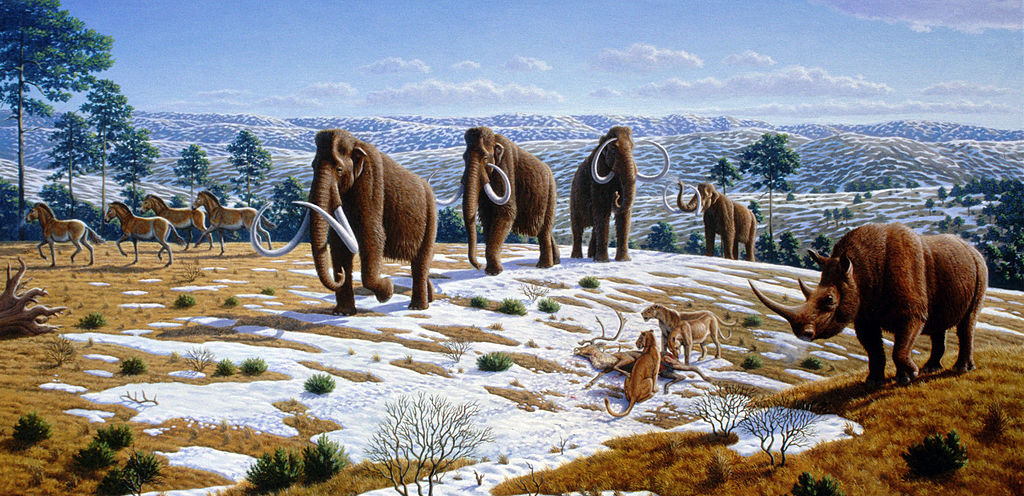Listen to Episode 25 on PodBean, Spotify, YouTube, or that other place you get podcasts!
Episode 5 and 15 were both about major extinction events of the past. Now, another ten episodes later, we’re back on the subject. This time, it’s the most recent major prehistoric extinction event, the one that took out the mammoths and other Ice Age giants, the first such event that our own species may have had a hand in: the Pleistocene Megafaunal Extinction.
In the news:
When is Archaeopteryx Not Archaeopteryx?
A re-examination of the “Haarlem Archaeopteryx” has concluded that it is not Archaeopteryx at all, but a new species of bird-like dinosaur, newly named Ostromia. [Link]
Dinosaur-Biting Ticks!
Several ticks preserved in amber are the first direct evidence of blood-sucking parasites going after dinosaurs, including one tick still clutching onto a dinosaur feather! [Link]
Animals of the Tibetan Plateau
As the Tibetan Plateau rose, nearby animals changed their distribution, migration pathways, and climate adaptations. These signs help scientists date the progress of the plateau. [Link]
The Teeth of Hibernating Bears
Two ancient bear skulls from Arctic Canada have cavities in their teeth, similar to what is seen in modern-day black bears as they eat lots of sugary fruits to fatten up for winter hibernation. [Link]
Pleistocene Megafauna
The Pleistocene Epoch lasted from around 2.6 million years ago to around 12,000 years ago. This was, famously, a time of cyclical climate change, alternating between glacial periods where glaciers and ice sheets covered huge swaths of continental land, and interglacials where ice retreated and sea levels rose.

Megafauna simply means “large animals,” and typically refers to land animals over 100 pounds (45kg). During the Late Pleistocene, there were about twice as many prominent species of megafauna around the globe, including many extremely large animals like mammoths, ground sloths, huge bison and camels and marsupials, and more.

During the last 50,000 years or so of the Pleistocene, around half of the world’s megafauna went extinct, including herbivores, carnivores, and nearly all of the multi-ton species (as well as some smaller animals). The loss of so many significant animals had some extreme consequences.
What Happened?
As always, trying to identify the cause of a mass extinction is challenging, but there were two major global events going on at this time, and especially during the highest pulse of extinction at the very end of the Epoch: 1. Changing climate and 2. the spread of Homo sapiens.
Exactly how these two factors played into the Pleistocene extinctions is the subject of much debate.
Climate change can create shifts in everything from temperatures to precipitation to season cycles to vegetation cover. Climate change has been linked to many past extinctions, and there is some convincing evidence for its role in the Pleistocene extinctions as well. That evidence is imperfect, however; hence the debate. Learn more here.

The Overkill Hypothesis is the catchy-sounding suggestion that, as humans spread across the globe, their penchant for hunting made quick work of large tasty mammals. The most striking evidence supporting this is timing: over the past 50,000 years, it seems that whenever humans show up somewhere new, extinctions follow. But there is some uncertainty; this correlation may not be as clear as it seems. Learn more here.
Researchers have also discussed the possibilities of other extinction factors. As humans spread to new environments, for example, they change habitats, introduce new species, and carry disease. It could also be that the extinction of only a few keystone species was necessary to kick off a cascade of environmental disturbance. And, of course, it’s likely that many or all of these factors played a part.
This is an exciting and active area of research, with new studies coming out all the time. In the podcast episode, we referenced studies from just this year finding possible evidence of moisture-related extinctions in Australia, and unexpectedly early human arrival in Australia and North America, all of which have implications for the Pleistocene extinctions.
—
If you enjoyed this topic and want more like it, check out these related episodes:
- Episode 24 – Sloths
- Episode 66 – Elephants
- Episode 113 – Paleoclimate
- Episode 55 – The “Sixth Extinction” (Modern Biodiversity Crisis)
We also invite you to follow us on Twitter, Facebook, or Instagram, buy merch at our Zazzle store, join our Discord server, or consider supporting us with a one-time PayPal donation or on Patreon to get bonus recordings and other goodies!
Please feel free to contact us with comments, questions, or topic suggestions, and to rate and review us on iTunes!
I’m working through your great episodes from the start so it will take me a long time to catch up. Have you discussed the Younger Dryas Inpact Hypothesis as an explanation for the megafauna extinction?
Great work !
LikeLike
Thanks for listening! We haven’t discussed that in detail on the podcast, but we’ll add it to the request list!
LikeLike